Jammu & Kashmir, the northernmost state of India, is blessed with a unique climate perfect for lavender farming. The state has been traditionally known for its saffron production. However, with the introduction of the Aroma Mission in 2016, there has been a shift toward lavender farming. Lavender is an aromatic plant with a long history of medicinal and culinary use.
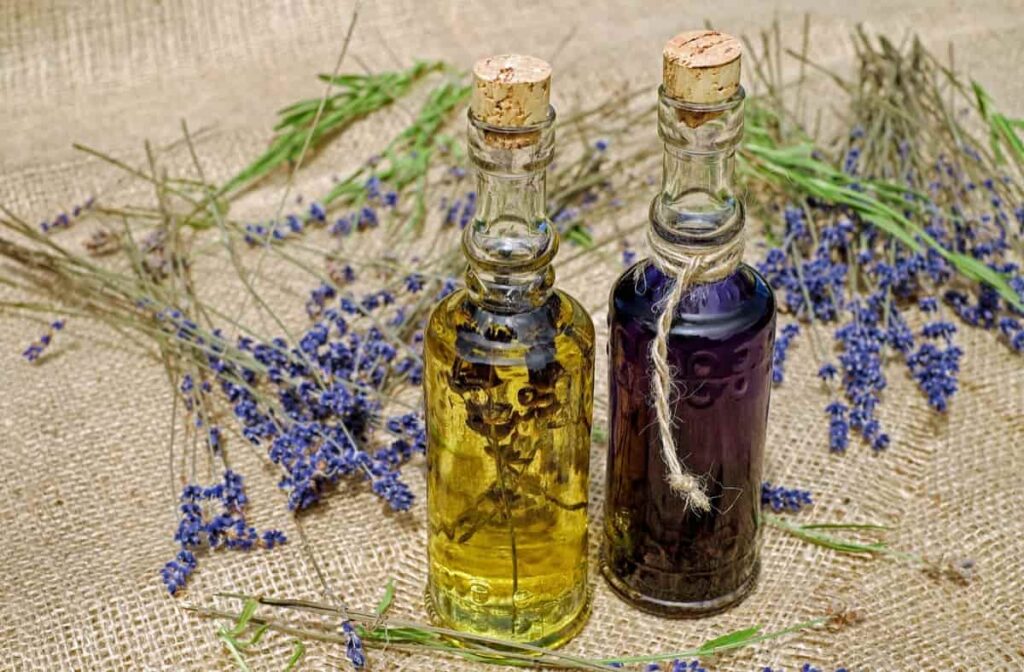
The plant is native to the Mediterranean but can now be found worldwide. In Jammu and Kashmir, Lavender is grown at an altitude of 1,600-2,000 meters above sea level. The Jammu and Kashmir government provides financial support to farmers who want to take up lavender cultivation. This financial support has increased the number of farmers growing lavender in the state.
Lavender farming in Jammu and Kashmir
Lavender farming in Jammu and Kashmir is an excellent way to earn profits while enjoying the stunning views of the snow-capped mountains. The state has been promoting lavender cultivation under the Aroma Mission, and the results have been very encouraging. Lavender farming requires very little investment, and the returns are pretty high. One can quickly start with a small piece of land and a few plants.
The climate in Jammu and Kashmir is perfect for lavender cultivation, and the flowers grow very well in this region. The best time to harvest Lavender is from June to August. The flowers are dried and used to make essential oils, highly prized in the perfume industry. Lavender oil has many therapeutic properties and is used in aromatherapy.
Lavender farming is a great way to earn an income while living in one of the best and most wonderful places on earth, which is Jammu and Kashmir. If you are interested in starting your lavender farm, many resources are available to help you get started. You could make excellent profits from your purple revolution!
What is Lavender farming?
Lavender farming in Jammu and Kashmir has been gaining popularity in recent years due to the high profits that it can generate. Lavender is a valuable crop due to its fragrant oil, which is used in various products, including soaps, perfumes, and cosmetics. The state of Jammu and Kashmir is well-suited for lavender cultivation due to its moderate climate and fertile soil. Lavender farming typically involves growing plants in rows and harvesting flowers by hand.
The harvested Lavender is then distilled to extract the essential oils. These oils are then sold to companies that use them in their products. Lavender farmers in Jammu and Kashmir have generated high profits due to the increasing demand for lavender oil globally. The state government has also been promoting lavender farming under its Aroma Mission initiative, which aims to boost the production of essential oils in Jammu and Kashmir.
In case you missed it: How to Grow Columbine Flowers: A Guide to Propagation, Planting, and Care
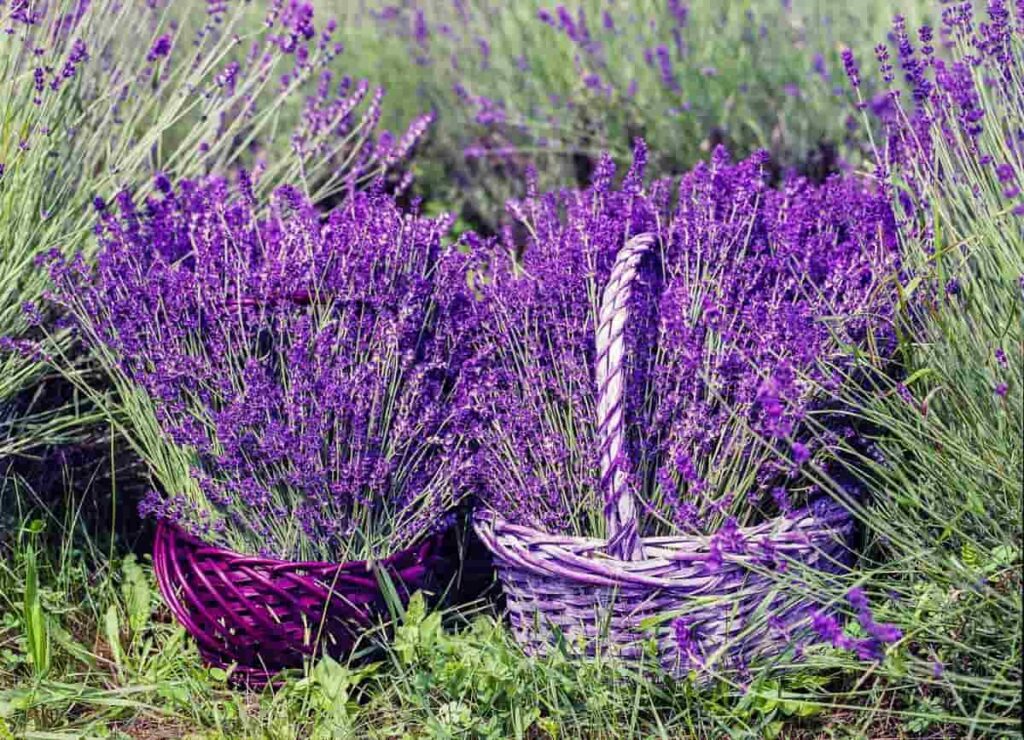
Under this initiative, the government provides financial assistance and training to farmers who want to take up lavender cultivation. This assistance has helped increase the popularity of lavender farming among small-scale farmers in Jammu and Kashmir.
The history of Lavender farming in Jammu and Kashmir
Lavender farming in Jammu and Kashmir is not a new phenomenon. The state has been home to this beautiful crop for centuries, and it has played an essential role in the economy and culture of the region. Lavender was first introduced to Jammu and Kashmir by the Mughals, who ruled the region from the 16th to 19th centuries. The crop quickly took root in the state’s rich soil and cooler climate and soon became an essential part of the local economy.
Today, Lavender is grown all over Jammu and Kashmir, with most farms concentrated in the northern parts of the state. Lavender farming has become an essential source of income for many farmers and plays a vital role in the state’s economy. The future looks bright for lavender farming in Jammu and Kashmir. With continued support from the government’s Aroma Mission initiative, promoting lavender cultivation across the state, more farmers are expected to take up this lucrative crop in the years ahead.
Why Lavender farming is an excellent profit-making opportunity
Lavender farming is an excellent profit-making opportunity because it is a highly versatile crop used for various purposes. Lavender oil is a valuable commodity used in the perfume and cosmetics industries, and the plant itself is also used in many culinary dishes. In addition, Lavender has a wide range of medicinal properties and can be used to make teas, tinctures, and other health-related products.
There are many reasons why lavender farming is an excellent profit-making opportunity. The plant is relatively easy to grow and care for, and there is a high demand for lavender products both domestically and internationally. With proper planning and marketing, lavender farmers can reap significant financial rewards from their crops.
Lavender growing season in India
Lavender farming in Jammu and Kashmir is an excellent way to earn profits while enjoying the Purple Revolution under the Aroma Mission. The region has a long history of lavender cultivation, and the climate is ideal for growing this fragrant herb. The best time to plant Lavender in Jammu and Kashmir is mid-October to mid-November. This period allows the plants to become established before the winter cold sets in.
The planting season extends from March to May, with April being the best month for lavender cultivation in Jammu and Kashmir. To ensure a good harvest, selecting a suitable site for lavender farming is essential. Make sure to have well-drained soil which is rich in organic matter. Lavender prefers a sunny location, but it can also tolerate some shade. Once you have selected a suitable site, you must prepare the soil for planting.
Lavender does not like soggy conditions, so it is vital to ensure the soil is well-drained. You can improve drainage by adding organic matter such as compost or manure to the soil. After preparing the soil, you must choose a suitable variety of Lavender for your farm. Wide varieties of Lavender are available, so selecting one well-suited to your climate and soil type is essential. Once you have chosen a variety of Lavender, you will need to purchase seeds.
In case you missed it: How to Grow Rajnigandha (Tuberose): Soil, Propagation, Flowering Season, Planting, and Care
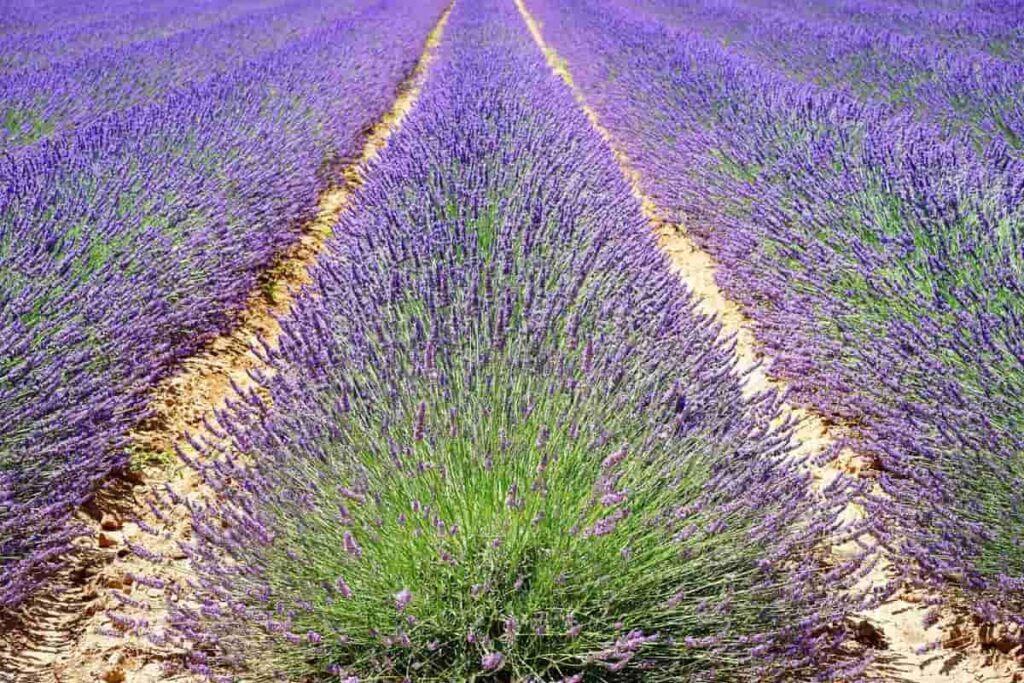
How to start your own Lavender farm
Lavender farming is an excellent way to earn profits in Jammu and Kashmir. The purple revolution under the Aroma Mission has enabled farmers to cultivate Lavender on a large scale and earn good money from selling the crop. Here are some tips and ideas on how to start your lavender farm in Jammu and Kashmir:
- Choose a suitable location for your farm. Lavender requires well-drained soil and full sunlight to grow well.
- Prepare the land by clearing it of all weeds and rocks. Break up large clumps of soil with a spade or hoe.
- Sow lavender seeds in rows, spacing them about 10 cm apart. Cover the seeds lightly with soil and water them gently.
- Keep the seedlings moist by watering them regularly. When the seedlings are fifteen centimeters tall, it is a good idea to thin out the weaker seedlings so that only the strong ones remain about 30 cm apart in each row.
- Apply a light dressing of fertilizer after the first month of growth and then once every two months. Use a balanced fertilizer such as 10-10-10. Water the plants deeply after each application of fertilizer.
- Harvesting begins when the plants are in full bloom, usually around mid-summer. You can cut the flower stalks with a sharp knife or shears, leaving about 5 cm of stem attached to each one.
Climate requirement for Lavender farming
Lavender herb is a beautiful and fragrant plant used for various purposes, from essential oils to potpourri. Jammu and Kashmir state in India is home to some of the best lavender farms in the world. The climate here is perfect for growing Lavender, with warm days and cool nights. Lavender requires well-drained soil and full sun to thrive, so Jammu and Kashmir’s climate is ideal.
Lavender farming has become an essential part of the economy in Jammu and Kashmir, as the state government has launched the Aroma Mission to promote the cultivation of aromatic plants. This initiative created an opportunity to increase lavender farming as more farmers rerealizedhe the profitability of this crop. With proper care and management, a lavender farm can yield excellent profits.
Soil requirement for Lavender farming
Lavender farming requires well-drained, sandy loam soil with a pH of 6.5 to 7.5. The ideal location for lavender farming is on a south-facing slope. The lavender plants require full sun for at least six to seven hours pedailyLavender will not tolerate waterlogged or highly alkaline soils. Lavender plants are deep-rooted and have a high water requirement during the active growth period from late spring to early summer.
In case you missed it: India Flower Planting Calendar: Month-wise Garden Sowing Chart, Dates Guide for Winter, Summer, and Rainy Season
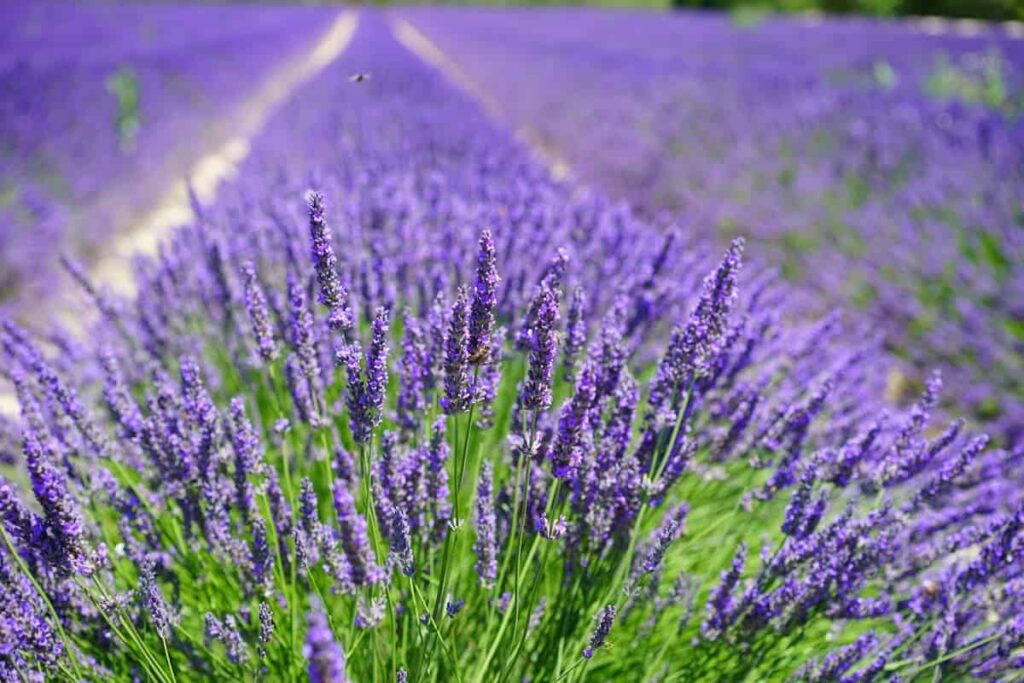
They are drought-tolerant and will survive without irrigation during periods of low rainfall. However, expect less yield if irrigation is not provided during dry periods. For preparing the soil for the planting of Lavender, it should be plowed to a depth of 20-30 cm and harrowed to create a fine-level seedbed. Add organic matter like compost to improve the soil structure and drainage. A dressing of lime may be necessary to correct the soil pH if it is too acidic.
Water requirement for Lavender farming
Lavender is one of the very popular and versatile herbs in the world, with a wide range of uses in cooking, cosmetics, aromatherapy, and medicine. The plant is hardy and can be grown in various climates but does best in full sun and well-drained soil conditions. Lavender requires little water to thrive. Too much water can be detrimental to the plant. When watering Lavender, always check the soil first to see if it is dry. If it is, give the plant a deep watering, saturating the root zone. The soil should dry out completely before for next irrigation or watering.
Lavender seed rate
The average seed rate for Lavender is between 2 and 3 pounds per acre. For a one-acre field, you will need between 80 and 120 pounds of lavender seed. You can purchase lavender seeds from a local farmer or grow your own. If you are growing your Lavender, starting with a small plot of land is best. This process will allow you to experiment with different planting densities and determine the optimal number of plants per square foot. Once you have determined the ideal plant density, you can calculate the necessary seed rate.
Once you have your lavender seeds, it is time to plant! Make sure to plant your seeds in well-draining soil and full sun. Lavender does not tolerate wet feet, so make sure to plant in an area that does not stay soggy after a rainstorm. After planting, water your Lavender regularly during the first growing season. Once established, Lavender is quite drought tolerant. However, if your area has scorching summers, you may need to water your plants more frequently during the peak heat.
How to care for Lavender plants
Lavender farming is gaining popularity in Jammu and Kashmir due to its excellent profits. The region has ideal conditions for growing Lavender, with its cool climate and ample sunlight. Lavender plants require very little maintenance and can be grown quickly in soil. Farmers need to purchase quality lavender seeds or seedlings from a reputable supplier to get started. They should also create a well-draining bed for their plants, as Lavender does not tolerate wet conditions.
Once the plants are established, you should carry out pruning regularly to encourage new growth. Harvesting typically takes place in late summer or early fall when the lavender flowers are at their peak. The lavender flowers are used fresh or dried for later use. When drying Lavender, it is crucial to do so slowly and carefully to preserve the plant’s fragrant oils. Jammu and Kashmir’s lavender farmers have an excellent opportunity to capitalize on the region’s ideal growing conditions and profit from this increasingly popular crop.
In case you missed it: How to Grow Potato Plants Faster: Best Tips to Increase Flowering, Fruiting, and Yield

Best fertilizers for Lavender
Lavender oil is one of the most popular essential oils in the world and has a wide range of applications, from aromatherapy to cosmetics. The Jammu and Kashmir state region is home to some of the best lavender farms in the world. The ideal time to plant Lavender is in spring or fall. The plants need full sun and well-drained soil. They are drought tolerant but prefer moderate moisture during their growth period.
Lavender does not require much fertilizer. A light application of a balanced fertilizer before blooming is all that is needed. Over-fertilizing can harm plants. Many different types of Lavender are available, including English, French, and Spanish varieties. Each type has its unique aroma and flavor profile. The best way to learn about lavender farming is to visit a farm in person so you can see the plants up close and learn about the different growing techniques used.
Greenhouse Lavender farming
Lavender farming in Jammu and Kashmir is an excellent profit-making venture under the Aroma Mission. The state is blessed with a conducive climate for the growth of this aromatic herb. Moreover, the increasing demand for lavender essential oil in the international market has made this crop a lucrative option for farmers in the region. Lavender can be grown both in open fields and under greenhouse conditions.
However, farmers in Jammu and Kashmir prefer to grow their plants under protected cultivation due to the harsh climatic conditions prevailing in the state. Greenhouse farming protects plants from extreme weather conditions and allows farmers to control the environment inside the structure as per the requirements of the crop. The ideal time for planting Lavender in Jammu and Kashmir is from mid-October to mid-November.
The plants take around 3-4 months to mature and are ready for harvest by early February. One hectare of land can yield up to 1500 kg of dried lavender flowers, which can be sold at an excellent price in the market. Lavender farming is relatively easy and does not require much input from farmers. However, adequate irrigation and drainage facilities are necessary to ensure a good yield. Farmers should also adopt appropriate post-harvest management practices to preserve the quality of their products.
In case you missed it: How to Grow Peas Faster: Best Tips to Increase Flowering, Fruiting, and Production Yield
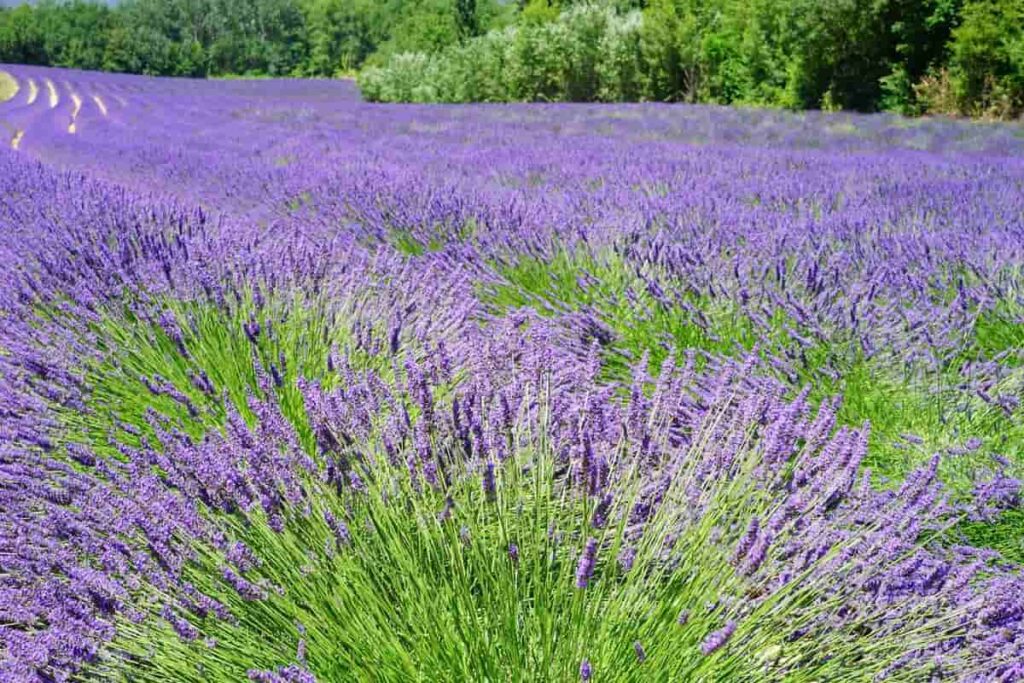
Where to sell Lavender in India
India is a vast market for Lavender, and there are many options for selling the product. Here are some ideas for where to sell Lavender in India:
- Lavender farms – There are many lavender farms in Jammu, Kashmir, and across India. These farms usually sell their products to wholesalers, but some may be open to selling directly to retailers or consumers.
- Local markets – Selling at local markets is a great way to reach many potential customers. Ensure a good quality product and attractive packaging to stand out from the competition.
- Online stores – Set up an online store to reach customers from all over India. You’ll need to invest in good-quality photos and descriptions and set up a reliable shipping process.
- Specialty stores – If you have a high-quality product, you may be able to sell it in specialty stores that cater to Lavender enthusiasts. These include boutiques, gift shops, and even home decor stores.
- Direct sales – You can also sell your lavender products directly to consumers through door-to-door sales or home parties. Direct sales marketing requires a lot of time and effort but can be very rewarding if done correctly.
- Broccoli Varieties: Choosing the Right Cultivars for Your Farm
- How to Raise Pigs in Your Own Backyard: A Comprehensive Guide
- Budget Friendly Sheep Shed Ideas: Cheap and Low-Cost Tips
- How Much Do Cattle Farmers Make: Revenue Streams in Cattle Farming
- Management Pests and Diseases in Your Cotton Field
- Sheep Farming Business Plan for Beginners
- Aquaponic Farming at Home: A Step-By-Step Guide
- Profitable Village Farming Business Ideas in 2024
- High-Yield Aquaculture: Fast-Growing Fish for Farming
- Effective Fish Pond Construction Techniques for Beginners
- Irrigation and Water Management in Pineapple Farming
- Blossom to Harvest: Mastering Flowering and Pollination in Papaya Farming
- Pig Fattening Essentials: From Selection to Sale for Beginners
- Raising Wagyu Cattle: A Complete Guide for Premium Beef Production
- Soil Types and Their Water Holding Capacity
- Optimizing Irrigation Schedules for Coconut Groves for Enhanced Yield
- Espresso Your Garden: Coffee Grounds for Healthier Acid-Loving Plants
- The Best Soil Mix for Snake Plants: How to Mix Your Own Snake Plant Soil
- Green Thumb Success: Expert Tips for Cultivating Greenhouse Beans All Year Round
- Bloom All Year Round: The Ultimate Guide to Indoor Hyacinth Care
- Eco-Friendly Gardening: How to Make Liquid Fertilizer from Kitchen Waste
- Ultimate Guide to Grow Anise in Pots: Explore Seed Propagation to Harvesting
- Guide to Raising Chester White Pigs: Discover Breed Facts to Growth Management
- Mastering the Elegance: The Ultimate Guide to Weeping Cherry Tree Care, Planting, and Maintenance
- Ultimate Guide to Planting Garlic in Grow Bags: Growing Strategies for Beginners
- How to Fix Spider Plant Leaf-Related Problems: Natural and Organic Remedies
- 10 Reasons Why Your Tulsi Plant is Shedding Leaves: Home Remedies and Solutions
- Optimizing Growth and Yield: The Advantages of Palm Bunch Ash Fertilizer
- Utilizing Neem Oil Extract as a Natural Pesticide for Hydrangea
- From Soil to Harvest: Various Ways in Which Farmers Can Use AI Tools
- Steps to Encourage and Induce Citrus Flowers: A Comprehensive Guide
- How to Fix Snake Plant Leaf-Related Issues: Natural and Organic Remedies
- Transform Your Garden into a Fragrant Oasis with Raat Ki Rani (Night Blooming Jasmine)
- Discover the Ideal Chicken Breeds for Philippine Farms
- How to Create a Poultry Egg Farm Business Plan for Profits
- Grow Lemon Cucumbers Like a Pro: Insider Techniques for Bountiful Yields

I require 5 litres of lavender essential oil every month. Please guide me how to approach farmers directly.